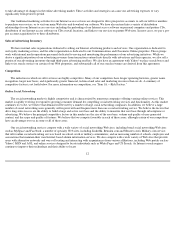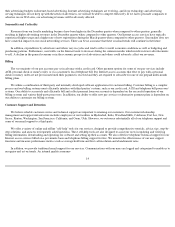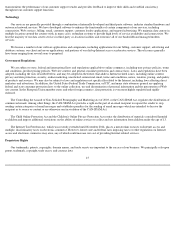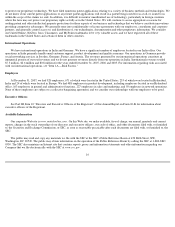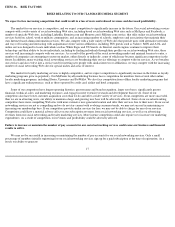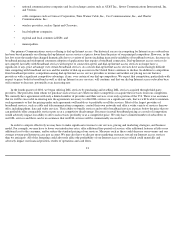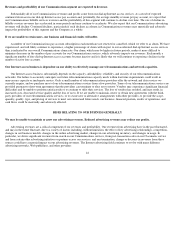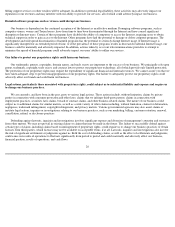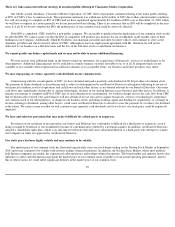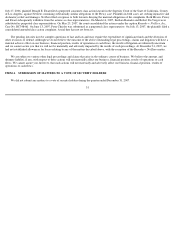Classmates.com 2007 Annual Report Download - page 23
Download and view the complete annual report
Please find page 23 of the 2007 Classmates.com annual report below. You can navigate through the pages in the report by either clicking on the pages listed below, or by using the keyword search tool below to find specific information within the annual report.
•
national communications companies and local exchange carriers such as AT&T Inc., Qwest Communications International, Inc.
and Verizon;
• cable companies such as Comcast Corporation, Time Warner Cable, Inc., Cox Communications, Inc., and Charter
Communications, Inc.;
•
wireless providers, such as Sprint and Clearwire;
• local telephone companies;
• regional and local commercial ISPs; and
•
municipalities.
Our primary Communications service offering is dial-up Internet access. Our historical success in competing for Internet access subscribers
has been based primarily on offering dial-
up Internet access services at prices lower than the prices of our principal competitors. However, in the
last few years the market has changed dramatically due to a variety of factors including increased availability of broadband services, decreases in
broadband pricing and widespread consumer adoption of applications that require a broadband connection. Dial-up Internet access services do
not compete favorably with broadband services with respect to connection speed, and dial-up Internet access services no longer have a
significant, if any, price advantage over certain broadband services. As a result, dial-up Internet access services have an increasingly difficult
time competing with broadband services and the number of dial-up accounts in the United States continues to decline. In addition to competition
from broadband providers, competition among dial-up Internet access service providers is intense and neither our pricing nor our features
provide us with a significant competitive advantage, if any, over certain of our dial-
up competitors. We expect that competition, particularly with
respect to price, both for broadband as well as dial-up Internet access services, will continue, and that our dial-up Internet access subscriber base
will continue to decrease, potentially at an increasing rate.
In the fourth quarter of 2006, we began offering DSL services by purchasing and reselling DSL services acquired through third-party
providers. The providers from whom we purchase such services are either our direct competitors or acquire their services from our competitors.
We currently have agreements with only a limited number of providers and their services cover only a portion of the U.S. There is no assurance
that we will be successful in entering into the agreements necessary to offer DSL services on a significant scale, that we will be able to maintain
such agreements or that the pricing under such agreements will enable us to profitably resell the services. Most of the largest providers of
broadband services, such as cable and telecommunications companies, control their own networks and offer a wider variety of services than we
offer, including phone, data and video services. Their ability to bundle services and to offer broadband services at prices below the price that we
can profitably offer comparable services puts us at a competitive disadvantage. Decreases in retail broadband pricing as a result of competition
would adversely impact our ability to offer such services profitably or at a competitive price. We only have a limited number of subscribers to
our DSL services and there can be no assurance that our DSL services will be commercially successful.
In order to compete effectively we may have to make significant revisions to our services, pricing and marketing strategies, and business
model. For example, we may have to lower our introductory rates, offer additional free periods of service, offer additional features at little or no
additional cost to the consumer, and/or reduce the standard pricing of our services. Measures such as these could decrease our revenues and our
average revenue per Internet access pay account. We may also have to allocate more marketing resources toward our Internet access services
than we anticipate. All of the foregoing could adversely affect the profitability of our Internet access services which could materially and
adversely impact our financial position, results of operations and cash flows.
21



